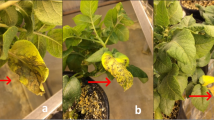Abstract
The concurrence of a decrease of the concentration of ribosomes and glycoproteins in leaves of potato plants under field conditions and mature plant resistance against potato virus YN was studied. On four of five dates with intervals of one or two weeks plants of randomly chosen plots in the field were inoculated. During plant growth sixth, tenth and fifteenth leaves of main stems were collected at regular intervals. With the aid of cellulose columns and polyethylene glycol-containing solvents the ribosome- en glycoprotein-contents (and in one experiment also the RNA-content) of these leaves were determined. Tubers were harvested from plants, inoculated fourteen days before. Lack of typical virus symptoms on plants grown from these tubers gave information on the presence of mature plant resistance.
It was concluded that in plants which had developed about 20 leaves, there was a high degree of mature plant resistance when ribosome- and glycoprotein-contents in the fifteenth leaf was less than 2 and 4 OD260/ml/g fresh weight respectively. When higher absorbance values are measured, mature plant resistance may or may not occur depending on environmental conditions. The ribosome- and glycoprotein-contents have a remote relation to the mature plant resistance. It is suggested that ribosome- and glycoprotein-contents of the youngest fully expanded leaves give the best indication of mature plant resistance.
Samenvatting
In veldproeven werde het verband tussen de concentraties van ribosomen en glycoproteinen in bladeren van aardappelplanten en de ouderdomsresistentie tegen aardappel YN-virus (PVYN) bestudeerd. Op vier of vijf data met tussenpozen van een of twee weken werden planten in het veld met PVYN geïnoculeerd. Gedurende de groeiperiode van de planten werden zesde, tiende en vijftiende bladeren op vastgestelde tijden verzameld. Chromatografische analyse met behulp van cellulosekolommen en solvents die polyethyleenglycol bevatten, leidde tot de bepalingen van de ribosoom- en glycoproteïnegehalten (en in één proef ook het RNA-gehalte) in de verzamelde bladeren. De oogst van de knollen vond plaats 14 dagen na inoculatie. Het niet tot ontwikkeling komen van de typische virussymptomen bij planten, die uit deze knollen waren gegroeid, was een aanwijzing voor het optreden van de ouderdomsresistentie.
Geconcludeerd wordt dat waarschijnlijk enige mate van ouderdomsresistentie tegen PVYN in een pootaardappelgewas aanwezig is, als het ribosoom- en glycoproteïnegehalte in het vijftiende blad van hoofdstengels met ongeveer twintig bladeren, leidt tot corresponderende extinctiewaarden bij 260 nm per ml en per gram vers gewicht van respectievelijk minder dan 2 en 4. Wanneer hogere extinctiewaarden worden gevonden kan ouderdomsresistentie wel of niet in belangrijke mate voorkomen, afhankelijk van de omstandigheden waaronder het gewas is gegroeid. Gesuggereerd wordt de jongste volledig ontwikkelde bladeren te gebruiken voor het aantonen van een gelijktijdig optreden van de afname in de ribosoom- en glycoproteïnegehalten en een praktisch waarneembare mate van ouderdomsresistentie.
Similar content being viewed by others
References
Beemster, A. B. R., 1961. Een vergelijking tussen het transport van X-virus en twee verschillende stammen van Y-virus in aardappelplanten (with a summary). T. Pl.-ziekten 67: 278–279.
Sandford, P. A., Nafziger, A. J. & Jeanes, A., 1971. Reaction of sodium hypochlorite with amines and amides; a new method for quantitating polysacharides containing hexosamines. Analyt. Biochem. 44: 111–121.
Schepers, A. & Reestman, A. J., 1975. Mature plant resistance against PVYN in relation to some morphological characteristics of the potato plant. Abstracts of Conference Papers, 6th triennial Conf. E.A.P.R., Wageningen, p. 100–102.
Venekamp, J. H. & Beemster, A. B. R., 1980a. Mature plant resistance of potato against some virus diseases. I. Concurrence of development of mature plant resistance against potato virus X, and decrease of ribosome and RNA content. Neth. J. Pl. Path. 85: 47–56.
Venekamp, J. H. & Beemster, A. B. R., 1980b. Mature plant resistance of potato against some virus diseases. II. Mature plant resistance and the influence of temperature on the ribosome and RNA content in leaves. Neth. J. Pl. Path. 85: 57–62.
Venekamp, J. H. & Taborsky, V., 1973. Changes in the quantity of ribosomes in healthy and virus-diseased plants during senescence. Neth. J. Pl. Path. 79: 62–69.
Wiersema, H. T., 1972. Breeding for resistance. In: J. A. de Bokx (Ed.): Viruses of potatoes and seed potato production. Pudoc, Wageningen, p. 174–187.
Author information
Authors and Affiliations
Rights and permissions
About this article
Cite this article
Venekamp, J.H., Schepers, A. & Bus, C.B. Mature plant resistance of potato against some virus diseases. III. Mature plant resistance against potato virus YN, indicated by decrease in ribosome-content in ageing potato plants under field conditions. Netherlands Journal of Plant Pathology 86, 301–309 (1980). https://doi.org/10.1007/BF01977285
Accepted:
Issue Date:
DOI: https://doi.org/10.1007/BF01977285




